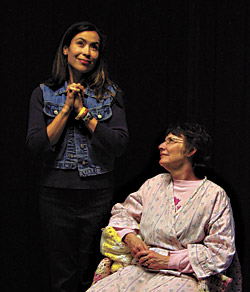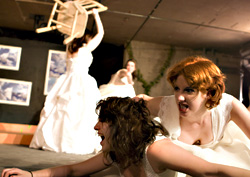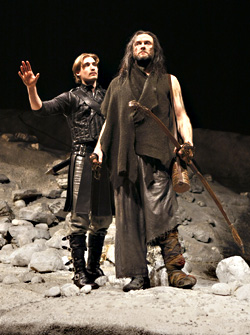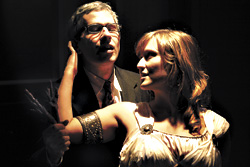RESPLENDENT in blond dreads and camouflage top at the W Hotel during her recent visit, director Catherine Hardwicke explained the lengthy, unlikely development of her debut film, Thirteen (see review, p. 97) “Fourth grade, I had these two girls I liked, Sally and Debbie.” They ditched her. “I called them the Sal-Deb Monster. I’d make drawings of how to kill the Sal-Deb Monster, because I wasn’t in the club.” As a grown-up, when Hardwicke broke up with her boyfriend, she decided to stay in the club of his family by retaining her bond with his daughter from a prior relationship, Nikki Reed, then 5. “I started getting my hair cut every couple weeks by her [divorced] mom, who works at home, like Holly Hunter in Thirteen.”
One day, angelic Nikki walked in as Teenage Monster Nikki. “She’s angry at everyone; there’s a cloud of teen angst over her. Her parents were like, ‘Hey, if you can do anything with herplease!‘” So Hardwicke took Nikki to museums, tried to pry her mind open. “I’d give her Jane Austeneeyugh! She’d do two hours on hair and makeup every day before seventh grade, but she wouldn’t read a book.” Fortunately, Nikki got interested in acting. “I told her a good actor has to write their own material, like Billy Bob Thornton or Johnny Cusack.” Nikki and Hardwicke started writing a teen comedy about a good girl and a bad girl, no doubt influenced by the Sal-Deb Monster.
As Hardwicke kept pressing Nikki for more real-life details”What would your friends say?”actual emotions and events infiltrated the comedy. “At surf-camp slumber parties at my house, I’d watch her and her mom and friends, and I’d see all these cultural touchstones happening. I said, ‘Why don’t we be brave and write a movie about the real shit?’ We wrote it in six days last January. Almost the next day, she went back to eighth grade, and I went to a party and told this woman about it. She said, ‘I’m a therapist working with troubled girlsthis sounds like them. Why don’t you tell my husband about it? He’s a producer.'” Hardwicke gave the guy a copy she just happened to have. He called back the next day and hooked her up with Holly Hunter. “I made a book with photos of Nikki at 12 wearing little overalls and, like, pigtails, and then six months later as, like, superhottie, and I filmed Nikki playing herselfthe Tracy character, not the one she plays in the [finished] movie. It’s loosely based on her life.
“Holly said, ‘I don’t want to play the mom, I want to play the girl. But I guess that’s not gonna happen.'” Hunter opened Hardwicke’s eyes to the underlying structure of the script’s amorphous story. “She said the movie was about trianglesmother/daughter/friendand one person gets kicked out.” Shades of Sal-Deb! “I realized I didn’t have one scene where the mother gets rejected. So on the plane home, I added two scenes [beefing up Hunter’s rejected-mom part], sent them when I landed, and she signed on Monday.” After a hectic 24-day shoot employing only two tripod shots, countless handheld shots, and the camera placed in a shopping cart plucked out of a gutter when a borrowed car needed for a tracking shot wouldn’t start, the film was done and en route to Sundance365 days after it was written.
Though it’s the scariest, realest teen film since Kids (1995), it’s distinct from Larry Clark’s hit, and not just because it lacks Clark’s intriguingly creepy voyeurism. “The big difference is my movie has parents in it. He totally stayed in the kids’ world. My interest is how [teen misbehavior] affects the mom and the fragile bond of family.” Yet she confirms that Thirteen only happened because she was creatively free to run amok, like Clark’s wild kidsshe had no meddlesome studio controlling the money nor paternal mandate to round off all the corners and make everyone likable. “I think that’s why it came out like it did.”







